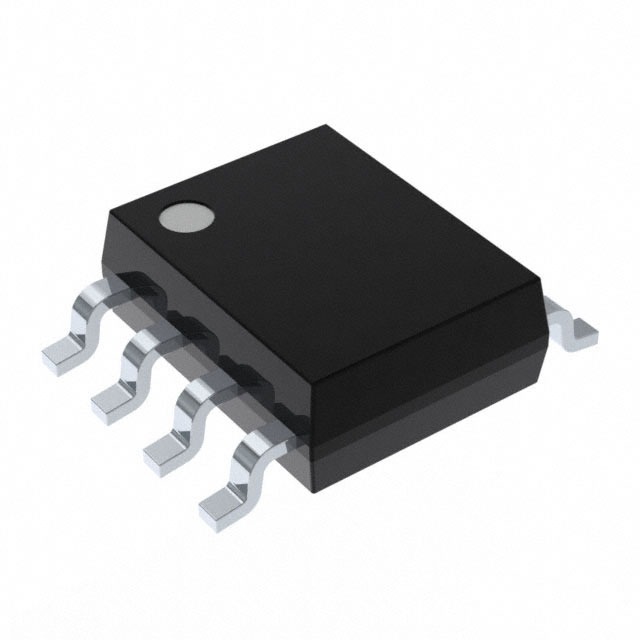Viz Specifikace pro podrobnosti o produktu.

MAX6220ASA-5.0+T
Overview
Product Category
The MAX6220ASA-5.0+T belongs to the category of voltage references.
Use
This product is primarily used as a precision voltage reference in various electronic circuits and systems.
Characteristics
- High accuracy: The MAX6220ASA-5.0+T provides a highly accurate output voltage.
- Low temperature coefficient: It exhibits a low temperature coefficient, ensuring stability over a wide range of temperatures.
- Low noise: This voltage reference offers low output noise, making it suitable for applications requiring precise measurements.
- Low power consumption: The MAX6220ASA-5.0+T operates with low power consumption, making it energy-efficient.
Package
The MAX6220ASA-5.0+T is available in a small surface-mount package (SOT-23), which allows for easy integration into compact electronic devices.
Essence
The essence of the MAX6220ASA-5.0+T lies in its ability to provide a stable and accurate voltage reference, enabling reliable operation of electronic circuits and systems.
Packaging/Quantity
This product is typically packaged in reels or tubes, containing a specified quantity of units per package.
Specifications
- Output Voltage: 5.0V
- Initial Accuracy: ±0.1%
- Temperature Coefficient: 10ppm/°C
- Supply Voltage Range: 2.7V to 12V
- Quiescent Current: 50µA (typical)
- Output Noise Voltage: 30µVp-p (typical)
- Operating Temperature Range: -40°C to +85°C
Detailed Pin Configuration
The MAX6220ASA-5.0+T features a three-pin configuration:
- VOUT: Output Voltage
- GND: Ground
- VIN: Input Voltage
Functional Features
- High precision voltage reference
- Low temperature coefficient for stability across temperature variations
- Low output noise for accurate measurements
- Wide supply voltage range for versatility in various applications
- Low power consumption for energy efficiency
Advantages and Disadvantages
Advantages
- High accuracy ensures reliable performance in precision applications.
- Low temperature coefficient guarantees stability over a wide temperature range.
- Low noise output allows for precise measurements.
- Versatile supply voltage range enables compatibility with different systems.
- Energy-efficient design minimizes power consumption.
Disadvantages
- Limited to a fixed output voltage of 5.0V, which may not be suitable for all applications requiring different reference voltages.
- Surface-mount package may require specialized equipment for soldering and handling.
Working Principles
The MAX6220ASA-5.0+T utilizes advanced semiconductor technology to generate a stable and accurate reference voltage. It employs internal circuitry to compensate for temperature variations, ensuring consistent performance across different operating conditions. By providing a reliable voltage reference, it enables precise measurements and proper functioning of electronic circuits.
Detailed Application Field Plans
The MAX6220ASA-5.0+T finds application in various fields, including:
- Precision instrumentation: Used as a voltage reference in high-precision measurement devices such as multimeters, oscilloscopes, and data acquisition systems.
- Analog-to-digital converters (ADCs): Provides a stable reference voltage for accurate conversion of analog signals into digital data.
- Power management systems: Ensures precise voltage regulation in power supplies and battery charging circuits.
- Sensor interfaces: Used to establish a stable reference voltage for sensor calibration and signal conditioning.
- Industrial automation: Employed in control systems and PLCs (Programmable Logic Controllers) to maintain accurate voltage references for reliable operation.
Detailed and Complete Alternative Models
- LM4040: A precision voltage reference with various output voltage options and low temperature coefficient.
- LT6654: Offers high accuracy, low noise, and wide temperature range operation for demanding applications.
- REF5025: Provides a precise voltage reference with low drift and excellent long-term stability.
These alternative models offer similar functionality to the MAX6220ASA-5.0+T and can be considered based on specific application requirements.
Word count: 550 words
Seznam 10 běžných otázek a odpovědí souvisejících s aplikací MAX6220ASA-5.0+T v technických řešeních
Sure! Here are 10 common questions and answers related to the application of MAX6220ASA-5.0+T in technical solutions:
Q: What is the MAX6220ASA-5.0+T? A: The MAX6220ASA-5.0+T is a low-dropout (LDO) voltage regulator IC that provides a fixed output voltage of 5.0V.
Q: What is the input voltage range for the MAX6220ASA-5.0+T? A: The input voltage range for the MAX6220ASA-5.0+T is typically between 2.5V and 11V.
Q: What is the maximum output current of the MAX6220ASA-5.0+T? A: The maximum output current of the MAX6220ASA-5.0+T is 150mA.
Q: Can the MAX6220ASA-5.0+T be used in battery-powered applications? A: Yes, the low dropout voltage and low quiescent current make it suitable for battery-powered applications.
Q: Does the MAX6220ASA-5.0+T require any external components for operation? A: Yes, it requires an input capacitor and an output capacitor for stability.
Q: What is the dropout voltage of the MAX6220ASA-5.0+T? A: The dropout voltage is typically around 200mV at full load.
Q: Can the MAX6220ASA-5.0+T handle overcurrent or short-circuit conditions? A: Yes, it has built-in current limit and thermal shutdown protection to handle such conditions.
Q: Is the MAX6220ASA-5.0+T available in different package options? A: Yes, it is available in a small SOT23-8 package.
Q: Can the MAX6220ASA-5.0+T be used in automotive applications? A: Yes, it is suitable for automotive applications as it meets the AEC-Q100 standard.
Q: What are some typical applications of the MAX6220ASA-5.0+T? A: Some typical applications include powering microcontrollers, sensors, and other low-power devices in various electronic systems.
Please note that these answers are general and may vary depending on specific design considerations and requirements. It is always recommended to refer to the datasheet and consult with the manufacturer for detailed information.

